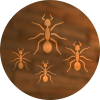Termites, also known as “silent destroyers,” are some of the most destructive and prevalent bugs to cause damage to your home. There are several types of termites, with the most common being the subterranean termites and drywood termites. Subterranean termites can be found in every state, with the exception of Alaska, and cause approximately 95% of all termite damage throughout the United States. Drywood termites typically inhabit southern climates.
Termite Damage
 Termites feed on wood and cellulose materials (dead plants and trees), including wood and wood mulch in your gardens. They burrow tunnels within the walls of your home or through the soil up to your home’s interior, causing damage to the house’s foundation and furniture. And because they are often burrowed in your walls, the signs of termite damage can go unnoticed for years.
Termites feed on wood and cellulose materials (dead plants and trees), including wood and wood mulch in your gardens. They burrow tunnels within the walls of your home or through the soil up to your home’s interior, causing damage to the house’s foundation and furniture. And because they are often burrowed in your walls, the signs of termite damage can go unnoticed for years.
Look for the Signs
 If you notice piles of wings, comparable to fish scales, around your home, this is a clear indicator that termites have taken over your home. These piles form after a swarm of termites have mated to start new colonies. The “reproductive” swarm typically occurs during springtime and is only temporary. Other signs of termite damage include hollow wood and cracked paint.
If you notice piles of wings, comparable to fish scales, around your home, this is a clear indicator that termites have taken over your home. These piles form after a swarm of termites have mated to start new colonies. The “reproductive” swarm typically occurs during springtime and is only temporary. Other signs of termite damage include hollow wood and cracked paint.
Termitariophiles
 There are organisms and other pests that live with termites or occupy a vacant termite habitat. This is known as termitariophiles. Carpenter ants are major culprits of moving into uninhabited termite-damaged homes. They will nest in the termite-damaged wood and pick up where the termites left off. Although carpenter ants might have taken over an old termite dwelling, that does not mean your home is termite-free. The termites could have simply relocated to another part of the home, leaving you with even more uninvited guests.
There are organisms and other pests that live with termites or occupy a vacant termite habitat. This is known as termitariophiles. Carpenter ants are major culprits of moving into uninhabited termite-damaged homes. They will nest in the termite-damaged wood and pick up where the termites left off. Although carpenter ants might have taken over an old termite dwelling, that does not mean your home is termite-free. The termites could have simply relocated to another part of the home, leaving you with even more uninvited guests.
Termite Prevention
 It is always a good idea to use pest control services to eliminate any bugs from your home. There are also some actions you can take to prevent termites from entering your home. Controlling the moisture in your home will reduce the risk of termites. A dehumidifier is one of the most effective ways to maintain your home’s moisture level. But you can also rid your roof and gutters of standing water, as well as repairing any leaking faucets and water pipes. Take these necessary actions and don’t underestimate the destruction of termites – otherwise you could be left with unrepairable damages.
It is always a good idea to use pest control services to eliminate any bugs from your home. There are also some actions you can take to prevent termites from entering your home. Controlling the moisture in your home will reduce the risk of termites. A dehumidifier is one of the most effective ways to maintain your home’s moisture level. But you can also rid your roof and gutters of standing water, as well as repairing any leaking faucets and water pipes. Take these necessary actions and don’t underestimate the destruction of termites – otherwise you could be left with unrepairable damages.